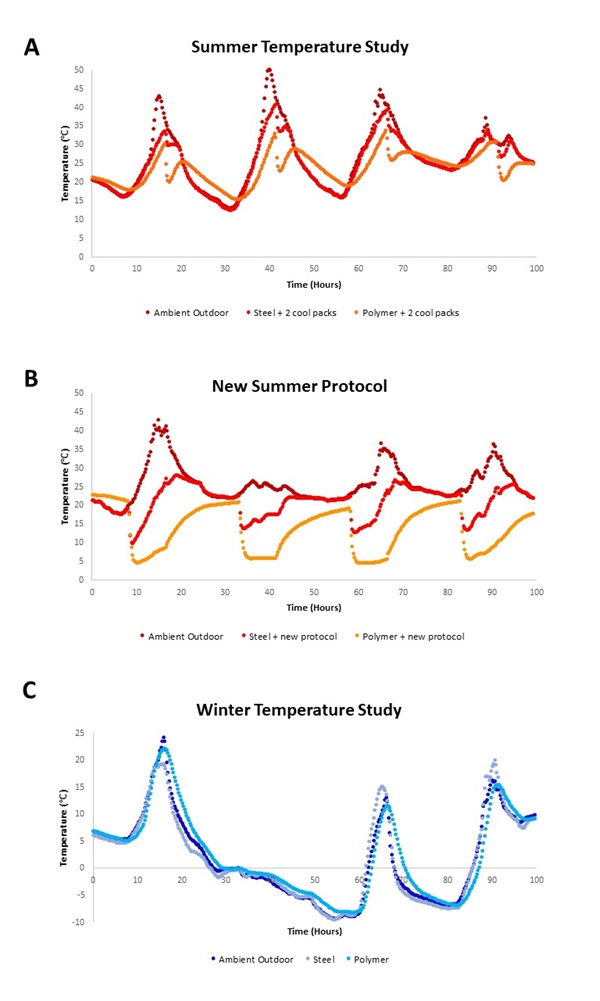Internal courier lockbox temperatures are often an overlooked source of potential preanalytical error (1,2). The most common lockboxes are made of steel insulated with Styrofoam, while others are made of polymers. Newer polymer designs are touted by manufacturers as able to protect samples for longer time periods than the traditional steel boxes in both winter and summer temperature extremes (3,4). The Clinical and Laboratory Standards Institute recommends sample storage temperatures during transport should be less than 22ºC (5). However, without required standardized lockbox instructions (e.g., placement, temperature monitoring, winter, and summer temperature guidelines) and thorough temperature studies investigating manufacturer design materials on internal lockbox temperatures, it is difficult to know if these recommended conditions are being met (1).
In 2019, Dibbern et al. investigated the short-term (≤4 h) effect of summer temperatures on centrifuged and uncentrifuged samples (Li-Heparin) stored in outdoor courier lockboxes. They found that samples stored in courier lockboxes in summer months could be exposed to temperatures greater than 40ºC in their geographic region and that aspartate aminotransferase, glucose, lactate dehydrogenase, and potassium were the most commonly affected analytes (1).
In 2021, our team determined optimal summer temperature profiles for two pairs of uniquely designed courier lockboxes (steel vs. polymer) by standardizing daily ice (-20ºC) and cool (4-8ºC) pack placement. In cycle one, we paired control steel and polymer lockboxes with no cool/ice packs (data not shown) with identical experimental lockboxes containing cool packs (n=2) as recommended by our institution during summer months and compared the internal temperatures of the two experimental lockboxes (Figure 1. Panel A). In cycle two, we proposed a new summer protocol in which frozen packs were placed in the morning and replaced with cool packs in the evening which successfully mitigated the effect of outdoor ambient temperatures on internal lockbox temperatures keeping them below 22ºC and compared the internal temperatures of the two types of lockboxes under the protocol (Figure 1. Panel B) (6).
Most recently, we compared the winter temperature profiles of the two lockboxes mentioned in the prior study (steel vs. polymer) to evaluate manufacturer advertising claims that polymer lockboxes can keep samples from freezing for 3.5 h as compared to only 0.25 h in steel lockboxes when exposed to outdoor temperatures of -9ºC (4). Our preliminary investigation demonstrated that there was no difference between the temperature profiles of steel and polymer lockboxes when exposed to these temperatures (Figure 1. Panel C), suggesting confusing claims in marketing materials (4).
Temperature profiles for summer and winter extreme temperature profiles are limited to non-existent in the published literature for steel and polymer lockboxes. In addition, manufacturers that make temperature claims for their product should provide relevant temperature study profiles with their marketing materials. This would allow consumers to make informed purchasing decisions that will better serve patient care. It remains important that laboratorians continue to investigate methods to help mitigate extreme seasonal temperatures since the boxes alone simply are inadequate. When it comes to the integrity of our patient samples (and lab’s geography), it may be prudent to heed the words of Robert Frost: “Some say the world will end in fire,/ Some say in ice” (7).

References
- Dibbern M, Pierre C, Wiencek J. Outdoor courier lockboxes in summer are a significant source of preanalytic error. Am J Clin Pathol. 2021;156(5):=66-870. doi:10.1093/AJCP/AQAB037
- Fantz C, Greene D. Where are the preanalytical stability standards? J Appl Lab Med. 2018;2(6):830-832.
- Wiencek J. Courier lock-boxes: is the wait the hardest part? AACC.org. Published online February 12, 2018. Accessed June 18, 2021. https://www.myadlm.org/science- and-research/scientific-shorts/2018/courrier-lock-boxes
- SampleSafeTM Specimen Lockboxes. Drucker Diagnostics. Accessed January 17, 2022. https://druckerdiagnostics.com/products/lock-boxes/
- Clinical and Laboratory Standards Institute. Procedures for the Handling and Processing of Blood Specimens for Common Laboratory Tests. In: Approved Guideline. 4th Ed. CLSI Document No. GP44-A4.; 2010.
- Hart S, Wiencek J. Temperature Optimization Within 2 Uniquely Designed Courier Lockboxes During Extreme Summer Temperatures. Am J Clin Pathol. Published online 2022. doi:https://doi.org/10.1093/ajcp/aqab216
- Frost R. Fire and Ice. Accessed January 17, 2022. https://www.poetryfoundation.org/poems/44263/fire-and-ice